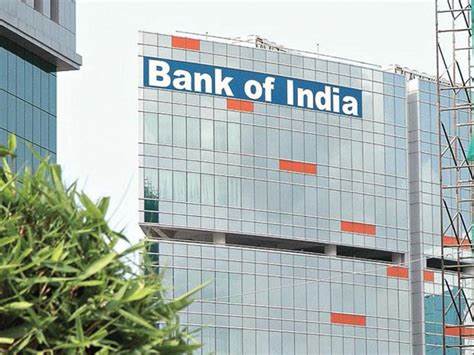Bank of India trades 3% up on 3-fold rise in Q1 net, better asset quality

Bank of India trades 3% up on 3-fold rise in Q1 net, better asset quality
Bank of India, one of India’s prominent financial institutions, witnessed a notable uptick in its shares, soaring by 3 percent during the early trade on July 31. The reason behind this surge was the announcement of the bank’s impressive financial results for the April-June quarter, which demonstrated a robust and healthy performance.
During the mentioned quarter, Bank of India reported a remarkable achievement in terms of its net profit, which soared to an impressive Rs 1,551 crore. This outstanding figure reflected a substantial growth rate, amounting to more than three times the net profit of Rs 561 crore reported in the corresponding period of the previous year. Such remarkable growth showcased the bank’s ability to effectively manage its financial assets and capitalize on favorable market conditions.

Another significant indicator of the bank’s strong performance was its net interest income (NII), which experienced a remarkable upsurge of 45 percent year-on-year, reaching an impressive figure of Rs 5,915 crore. The NII is a crucial metric for any bank, as it illustrates the difference between the interest earned on loans and the interest paid on deposits. The considerable increase in NII demonstrated Bank of India’s adeptness in efficiently managing its interest-earning assets and liabilities.
Furthermore, Bank of India’s net interest margin (NIM) registered a noteworthy improvement during the April-June quarter. The NIM, which represents the difference between the interest income generated from loans and the interest expenses incurred on deposits and borrowings, increased by 51 basis points. This achievement led to a rise in the net interest margin from 2.87 percent in the corresponding period last year to an enhanced 3.37 percent. The improved net interest margin signaled enhanced profitability for the bank, providing investors and stakeholders with a positive outlook.
The positive financial results for the quarter were attributed to an improvement in the bank’s asset quality. With the bank experiencing a decrease in non-performing assets (NPAs), it could allocate fewer provisions for potential loan losses, further contributing to its increased profitability. The reduction in NPAs also reflected Bank of India’s prudent risk management practices and ability to maintain a healthy loan portfolio.
As a result of these remarkable financial achievements, Bank of India received favorable attention from investors, driving an upswing in the market value of its shares. The noteworthy increase in share price was a testament to the confidence that investors had in the bank’s ability to deliver consistent growth and maintain its financial strength.

In conclusion, Bank of India’s strong performance in the April-June quarter showcased its resilience and effective strategies in navigating the economic landscape. The substantial increase in net profit, net interest income, and net interest margin, along with an improvement in asset quality, positioned the bank as a formidable player in the banking industry and attracted positive market sentiment.
During the April-June quarter, Bank of India, as a state-run lender, demonstrated a notable improvement in its asset quality. The bank’s gross non-performing assets (NPAs) declined to 6.67 percent, a positive development compared to the previous quarter’s figure of 7.31 percent. Additionally, the bank’s net NPA ratio also improved, decreasing slightly to 1.65 percent from 1.66 percent in the previous quarter. These reductions in NPAs indicate that the bank managed to recover or resolve problematic loans, leading to a healthier loan book and reduced credit risk.
The positive financial results and the improvement in asset quality during the quarter had a favorable impact on the market perception of Bank of India. At 9.19am, shares of the bank were actively traded on the National Stock Exchange at a price of Rs 85.60. This represented a 1.9 percent increase from the previous day’s closing price, further reflecting the investor’s confidence in the bank’s performance and its ability to generate value for its shareholders.
The decline in NPAs and the consequent improvement in asset quality not only boost the bank’s financial performance but also enhance its overall credibility in the market. Investors’ response to the increase in share price indicates a positive sentiment towards Bank of India, suggesting that they anticipate continued growth and profitability in the future. The bank’s management and prudent risk management practices are likely to be appreciated, reinforcing its position as a reputable and stable player in the banking sector.
Brokerages are expressing optimism and positive views regarding Bank of India, particularly due to its impressive earnings performance. One such foreign brokerage firm, Morgan Stanley, specifically praised the bank’s robust asset quality and strong balance sheet, which indicates sound financial health and stability.
In light of these positive attributes, Morgan Stanley has decided to maintain its “overweight” rating on Bank of India, signifying a recommendation to overweight the bank’s stock in an investment portfolio compared to its benchmark. The firm has set a price target of Rs 120, suggesting that they believe the bank’s shares have the potential to reach this level in the future.
Morgan Stanley further highlighted that Bank of India’s Net Interest Income (NII) and core revenues for the period under review met the brokerage’s estimates. This is a positive sign as it indicates that the bank performed as expected in terms of generating interest income from its lending activities and other core revenue streams. Moreover, despite adjusting for higher interest income arising from an income tax (IT) refund, the bank’s NII and core revenues still matched Morgan Stanley’s projections, which reaffirms the bank’s solid financial management and efficient handling of its financial transactions.
Overall, the favorable assessments from Morgan Stanley and other brokerages indicate a strong vote of confidence in Bank of India’s performance and potential for growth. The “overweight” rating and the price target of Rs 120 further suggest that the bank’s shares are likely to be viewed as an attractive investment option in the market, drawing the attention of investors who seek promising opportunities in the banking sector.



